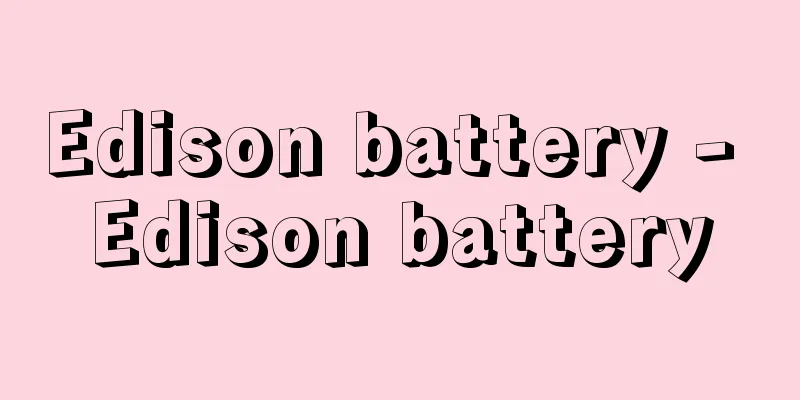Edison battery - Edison battery

|
It is a type of alkaline storage battery that uses nickel oxyhydroxide (NiOOH) for the positive electrode, iron (Fe) for the negative electrode, and potassium hydroxide (KOH) for the electrolyte. It was invented almost simultaneously in 1901 by American Thomas Edison and Swedish Waldemar Jungner (1869-1924), and is called the Edison battery because Edison developed the tubular positive electrode and put it to practical use in 1908. It is also called a nickel storage battery. It is the first battery system developed as an alkaline storage battery. The discharge reaction is shown below, and the discharge reaction of the positive electrode is the same as that of nickel-cadmium storage batteries and nickel-metal hydride storage batteries. (Positive electrode) Initially, a tube-type electrode was used for the nickel oxyhydroxide positive electrode, but later a sintered electrode and then a foamed metal electrode (non-sintered electrode) were used to increase capacity. A pocket-type electrode was also put to practical use for the iron negative electrode. However, later, a method was adopted in which spongy high-purity iron powder with a large specific surface area was made into a slurry (a suspension of crushed material) with water and a thickener, which was then applied to the electrode support and sintered, improving the negative electrode characteristics. Woven or non-woven fabrics such as nylon or polypropylene were used for the separator, and a 20-35% KOH aqueous solution with added potassium sulfide, antimony pentoxide, sulfamic acid, etc. was used for the electrolyte to improve discharge capacity and reduce self-discharge. Because the raw materials are inexpensive and it is expected that the battery can be manufactured at low cost, research and development of Edison batteries for electric vehicles was carried out in Japan from 1971 to 1977 (Showa 46-52) based on the Large-Scale Industrial Technology Development System of the Ministry of International Trade and Industry (now the Ministry of Economy, Trade and Industry). An energy density of 77.5 kWh/kg was achieved, and a charge/discharge cycle life of more than 500 times was achieved. However, when left unused for a long period of time, the battery self-discharged significantly, and not only the discharge capacity but also the discharge voltage decreased, leaving major issues for practical use. In addition, hydrogen gas was generated from the iron negative electrode during charging, making it difficult to completely seal the battery, and periodic replenishment of electrolyte was required. However, no effective technical measures to solve these problems have been found, and the battery is hardly produced at present. [Mitsuru Asano] "Electrochemical Society, ed. Electrochemical Handbook (2000, Maruzen)" ▽ "Ogumi Zenpachi and Ikeda Hironosuke eds., Secondary Battery Technology for Beginners (2001, Industrial Research Institute)" ▽ "Nawa Kotaro, Entrepreneur Edison: Intellectual Property, Systems, and Market Development (2001, Asahi Shimbun)" [Reference] | | |Source: Shogakukan Encyclopedia Nipponica About Encyclopedia Nipponica Information | Legend |
|
正極にオキシ水酸化ニッケルNiOOH、負極に鉄Fe、電解液には水酸化カリウムKOHを用いるアルカリ蓄電池の一種である。1901年にアメリカのエジソンとスウェーデンのユングナーWaldemar Jungner(1869―1924)によってほとんど同時に発明され、1908年にエジソンがチューブ式正極を開発して実用化したためエジソン電池とよばれている。ニッケル蓄電池ともいう。アルカリ蓄電池として最初に開発された電池系である。放電反応は以下のように示され、正極の放電反応はニッケルカドミウム蓄電池やニッケル水素蓄電池と同じである。 (正極) オキシ水酸化ニッケル正極は、当初チューブ式電極が用いられたが、その後焼結式電極、ついで発泡メタル式電極(非焼結式電極)が使用され、高容量化が図られた。また鉄負極はポケット式が実用化された。しかしその後比表面積の大きい海綿状の高純度鉄粉末を水と増粘剤でスラリー(粉砕物の懸濁液)化し、電極支持体へ塗着後焼結する方法が採用され、負極特性が改善された。そしてセパレーターにはナイロンやポリプロピレンなどの織布や不織布などが用いられ、電解液には放電容量の向上と自己放電を少なくするために硫化カリウムや五酸化アンチモン、スルファミン酸などを添加した20~35%KOH水溶液が用いられた。 原材料が安価であり、低コストで製造することが期待できるため、わが国では通商産業省(現経済産業省)の大型工業化技術開発制度に基づいて、1971~77年(昭和46~52)に電気自動車用エジソン電池の開発研究が行われた。そしてエネルギー密度として77.5kWh/kgが得られ、500回以上の充放電サイクル寿命が達成されたが、長期間放置した場合の自己放電が大きく、放電容量だけでなく放電電圧も低下し、実用化にあたって大きな課題が残った。また充電時に鉄負極から水素ガスの発生がみられ、電池の完全密閉化が困難で、定期的補液を必要とした。しかし、これらを解決できる有効な技術対策が得られず、現在ではほとんど生産されていない。 [浅野 満] 『電気化学会編『電気化学便覧』(2000・丸善)』▽『小久見善八・池田宏之助編著『はじめての二次電池技術』(2001・工業調査会)』▽『名和小太郎著『起業家エジソン――知的財産・システム・市場開発』(2001・朝日新聞社)』 [参照項目] | | |出典 小学館 日本大百科全書(ニッポニカ)日本大百科全書(ニッポニカ)について 情報 | 凡例 |
>>: Edison Electric Lighting Company
Recommend
American larch - American larch
...They are also planted as garden trees for thei...
Diamond Wisdom - Vajrayana
Indian monk. His Sanskrit name was Vajrabodhi. He...
common benefit
...Since ancient Greece, it has been one of the f...
Explosion earthquake
Andesitic volcanoes exhibit explosive eruptions, a...
Chattonella (English spelling)
An alga that grows in large numbers in the Seto In...
Kinjosan (English spelling) Kǔmsŏng‐san
Jinsan, Naju, Jeollanam-do, Korea. It is still a m...
"The Complete Record of Imperial Poems"
…In addition, the Qing army, which had Siam (toda...
Colitis - daichouen (English spelling) colitis
A general term for inflammatory diseases of the l...
Northern Expedition
In China, the Northern Expedition generally refer...
Plastic model - Plastic model
An assembly model toy made of plastic parts. It i...
Callimatobacterium granulomatis - Callimatobacterium granulomatis
…chancroid caused by the bacteria Carymatobacteri...
Female labor - Joseiroudou
It usually refers to women's employed labor (...
Sebastiano Serlio
Italian architect and theorist. Born in Bologna. ...
Kayu-sekku - Kayu-sekku
...The gods are invited to the festival, and peop...
Yokkaichi asthma - Yokkaichi asthma
It is one of the most common pollution-related di...







![Antisemitism (English spelling) Antisemitismus [Germany]](/upload/images/67cae23b97306.webp)

